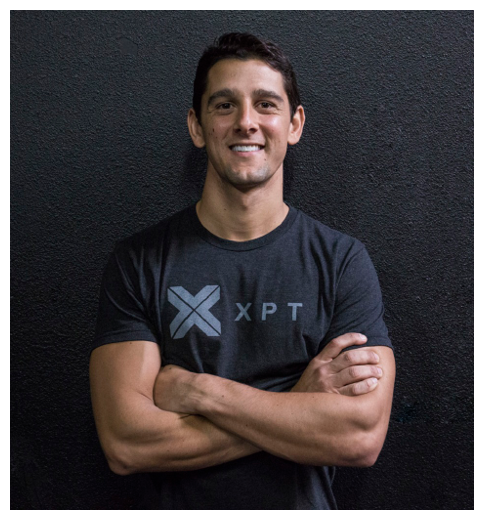How to Use Breathing, Heat, and Cold for Health and Athletic Performance
Dec. 19, 2018
Coach PJ Nestler is a human performance specialist with a life mission to help athletes and coaches realize their full potential. With over 10 years of experience preparing top athletes for competition, PJ has trained dozens of athletes from the UFC, NFL, NHL, and MLB. He has also worked extensively with over 100 fighters, including Brazilian Jiu-Jitsu World Champions and Top 10 ranked UFC fighters.
 On this podcast, NBT Coach Clay Higgins talks with Coach PJ about his role as the Director of Performance with XPT Life, which includes researching, educating, and training based on XPTs Breathe-Move-Recover foundational pillars. PJ discusses the value of breathing protocols to sustain health and improve athletic performance. They also look at exposure to extreme heat and cold for hormetic benefits and offer some things to consider before adding these strategies to your training regimen.
On this podcast, NBT Coach Clay Higgins talks with Coach PJ about his role as the Director of Performance with XPT Life, which includes researching, educating, and training based on XPTs Breathe-Move-Recover foundational pillars. PJ discusses the value of breathing protocols to sustain health and improve athletic performance. They also look at exposure to extreme heat and cold for hormetic benefits and offer some things to consider before adding these strategies to your training regimen.
Here’s the outline of this interview with PJ Nestler:
[00:01:00] XPT Experience; Laird Hamilton and Gabby Reece.
[00:02:39] Pool training exercises.
[00:07:08] Exploration breathing sessions.
[00:09:22] The rise of breath work as the key to performance.
[00:13:30] Dysfunction in breathing: causes and effects.
[00:16:05] Controlling breath to create the intra-abdominal pressure needed to lift.
[00:17:46] Relief of anxiety.
[00:19:27] The physiology behind different breathing protocols: Understanding the why.
[00:22:41] Identifying the best breathing protocol for an individual.
[00:26:00] Mouth taping.
[00:27:06] Somnifix strips.
[00:29:39] Sleep hygiene; circadian rhythm.
[00:30:41] Functional Range Conditioning (FRC).
[00:30:59] Controlled Articular Rotations (CARS).
[00:31:50] Nighttime routine.
[00:34:19] ChiliPad.
[00:35:48] Cold therapy.
[00:36:41] Using breath to lower heart rate and blood pressure, decrease sympathetic nervous system activity; Studies: Zou, Yan, et al. "Meta-Analysis of Effects of Voluntary Slow Breathing Exercises for Control of Heart Rate and Blood Pressure in Patients With Cardiovascular Diseases." The American journal of cardiology 120.1 (2017): 148-153; and Hering, Dagmara, et al. "Effects of acute and long-term slow breathing exercise on muscle sympathetic nerve activity in untreated male patients with hypertension." Journal of hypertension 31.4 (2013): 739-746.
[00:38:28] Physiological benefits of exposure to extreme heat; Studies: For depression in cancer patients: Koltyn, K. F., et al. "Changes in mood state following whole-body hyperthermia." International journal of hyperthermia 8.3 (1992): 305-307; In cardiovascular disease: Laukkanen, Jari A., Tanjaniina Laukkanen, and Setor K. Kunutsor. "Cardiovascular and other health benefits of sauna bathing: a review of the evidence." Mayo Clinic Proceedings. Vol. 93. No. 8. Elsevier, 2018; In diabetes: Krause, Mauricio, et al. "Heat shock proteins and heat therapy for type 2 diabetes: pros and cons." Current Opinion in Clinical Nutrition & Metabolic Care 18.4 (2015): 374-380; In rheumatic disease, asthma, and chronic bronchitis: Hannuksela, Minna L., and Samer Ellahham. "Benefits and risks of sauna bathing." The American journal of medicine 110.2 (2001): 118-126.
[00:39:20] Hormesis.
[00:40:47] Sauna and cold exposure: What temperature and for how long?
[00:42:10] Research suggests benefit at 175 to 220 degrees Fahrenheit for 15-30 minutes, 2+ times/week.
[00:46:28] Cold exposure for athletic recovery; Study: Versey, Nathan G., Shona L. Halson, and Brian T. Dawson. "Water immersion recovery for athletes: effect on exercise performance and practical recommendations." Sports medicine 43.11 (2013): 1101-1130.
[00:48:19] Find PJ on Instagram, on YouTube, Facebook, xptlife.com.
© 2013-2025 nourishbalancethrive